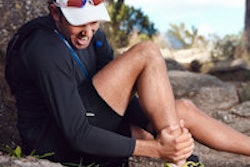
LAS VEGAS - U.S. short-track speed skater J.R. Celski seemed unlikely to compete at the 2010 Winter Games five months after his skate sliced into his thigh after a fall in a race. Thanks in part to ultrasound, however, Celski made it to Vancouver and won two bronze medals, according to a talk at this week's American Institute of Ultrasound in Medicine (AIUM) meeting.
Although Celski gets all the credit for his remarkable comeback, ultrasound showed when his hematoma had resolved and the musculoskeletal aspects of his quadricep had come back together, said Dr. Bill Moreau, managing director of the U.S. Olympic Committee (USOC) Sports Medicine Division and medical director for Team USA at the Sochi and London Olympic Games. This knowledge enabled Celski to resume training earlier than expected.
"We were hoping to get him on the ice in December, but he actually returned to the ice on Thanksgiving," he said.
Ultrasound is now a crucial tool
Since Celski's injury and remarkable recovery, diagnostic ultrasound has continued to emerge as a crucial tool for imaging musculoskeletal pathology in U.S. Olympic athletes, surpassing MRI.
"When utilization of musculoskeletal ultrasound went up, the utilization of MR started to go down," said Moreau, who spoke during a plenary session at AIUM 2014.
To get a sense of the role of ultrasound in the care of U.S. Olympic athletes, researchers recently tabulated studies ordered by USOC staff on athletes seen in the Colorado Springs Olympic Training Center sports medicine clinic. The clinic has in-house access to x-ray, musculoskeletal ultrasound, extremity MRI, and dual-energy absorptiometry (DEXA), and outside access to MRI, CT, nuclear medical studies, and other exams, Moreau said.
The following imaging studies were ordered in 2012:
- X-ray: 308
- Musculoskeletal ultrasound: 284
- MRI: 34
- CT: 2
Continued increases
The number of diagnostic ultrasound studies ordered has continued to increase over time, climbing from 33 in 2011 to 284 in 2012 and 364 in 2013, Moreau said. The clinic ordered 284 MRIs in 2011, 34 in 2012, and 176 in 2013.
The study showed that clinicians like to use a number of different imaging modalities for diagnosing and managing athletes.
"As competence improved and training increased [with diagnostic ultrasound], so did the utilization of the modality," he said. "We think ultrasound provides a key methodology for imaging musculoskeletal pathology."
For example, clinicians are very interested in distinguishing between tendinitis and tendinosis, according to Moreau.
"If you can understand what type of tendinopathy that you are actually managing, you can immediately get that patient on the correct care pathway on the first day of the encounter," he said. "And that provides for a better outcome."
USOC Sports Medicine views musculoskeletal ultrasound as an immediate and noninvasive extension of the physical examination, Moreau said. It also allows dynamic studies and serves as a cost-effective tool for imaging musculoskeletal injury.
Furthermore, musculoskeletal ultrasound provides objective imagery of acute injury and conditions throughout the recovery process, leading to expedited management plans.
"With musculoskeletal ultrasound, you can actually watch the tissue heal," he said. "You can see when the tissue is reunited, and when that happens we press on to the rehab program."
Olympic Games
Ultrasound was also commonly used onsite at recent Olympic Games. At the 2012 Summer Games in London, 1,711 imaging studies were performed. Of these, 49% were MRI, 24% were x-ray, 23% were ultrasound, and 5% were CT.
The most common injuries for Team USA were overuse musculoskeletal issues. While fracture was rare, stress fractures were the most common fractures encountered, Moreau said.
"Diagnostic ultrasound was readily utilized because of the access to experts, equipment, and type of injury evaluated," he said.
At the recent 2014 Winter Games in Sochi, there were 486 total diagnostic imaging scans:
- X-ray: 210 (43%)
- MRI: 140 (29%)
- Ultrasound: 120 (25%)
- CT: 16 (3%)
USOC is involved in a number of research projects involving the use of ultrasound, including an initiative to study infrapatellar tendon characteristics in Olympic weight lifters and the correlation between training activities and tendon structures.
Other projects underway include baseline sonographic evaluation of elite swimmers' shoulders and sonographic evaluation of anterior knee pain (for distinguishing between tendinopathy and fat pad pathology), according to Moreau.
"Musculoskeletal ultrasound does a really nice job of imaging that so we can do some interventions," he said.
Future directions could include using musculoskeletal ultrasound to perform glycogen monitoring.
Movement-based medicine
USOC is also working on movement-based medicine to identify pathologies before they occur, Moreau said. Dysfunctional movements over time can lead to pathological tissue; with enough of a change, this will progress to an orthopedic diagnosis.
"What if we could somehow break that chain?" he asked. "What if we could identify dysfunctional movements and pathologic changes in tissues before they actually become a pathology, do an intervention, and stop that from proceeding? What if we could identify the common characteristics where we could say, if you have these five characteristics, it's highly likely that you're going to have a problem with your rotator cuff within a period of time?"
The concept of regional interdependence also applies, in which seemingly unrelated movements in a remote anatomic region may contribute to or are associated with the patient's primary complaint, according to Moreau.




















